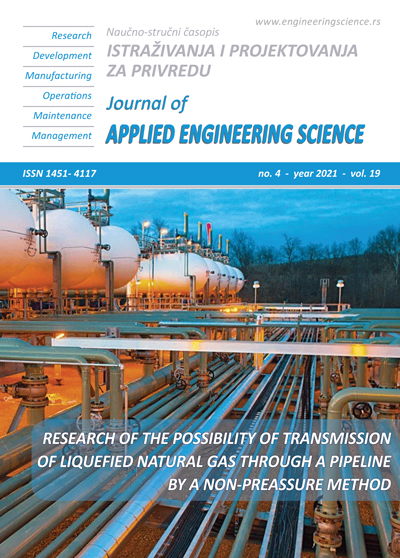INVESTIGATING THE BEHAVIOR OF PILED RAFT FOUNDATION IN CORE WALL FOUNDATION OF HIGH-RISE BUILDINGS
Abstract
Core structure is an indispensable part of high buildings. Normally, the foundation of the core structure has a raft of larger size than the other foundations in the same project; therefore, the foundation of the core structure can be viewed as a small piled raft foundation. Currently, when calculating the piled foundation of the core, it is mostly assumed that the piles system will bear all the project loads. But this calculation method is not suitable for the actual constructions as well as does not make full use of the bearing capacity of the structure and the ground, leading to using more materials and causing more waste. Core structure aims to increase both stiffness and horizontal load capacity in high-rise buildings, so the moment inside the core transmitted to the foundation is very large. One of the shortcomings of the Plaxis 3D Foundation software is its inability to declare the moment affecting on the foundation due to the loads in this program just includes distributed loads, line loads and point loads in the geometry model. Consequently, when using Plaxis 3D Foundation software to calculate the core wall foundation of high-rise buildings, this moment is converted into an equivalent pair of moments. The research shows that when the core foundation of a high-rise building is placed on soft soil, the pile carries 96%, most of the load transmitted to the foundation. However, when the foundation is placed on hard soil, the soil surrounding the raft will bear about 10% of the load transmitted to the foundation. If this matter is skipped, there will be a large error in calculation and design
References
[2] Beckett D. (2000). Design Application of Raft Foundation. 1st edition, Thomas Telfort books, London, page 1-38.
[3] Bowels J.E. (1996). Foundation Analysis and Design, Mcgraw Hill International Edititons.
[4] Desai, C. S., Johnson, L. D., and Hargett, C. M. (1974). Analysis of pile supported gravity lock. J. Geotech. Engng, ASCE, 100(9), 1009-1029.
[5] Hain, S.J, Lee I.K. (1978). he analysis of flexible raft-pile systems. Geotechnique 28, 1, pp. 65-83.
[6] Hassen, G and de Buhan, P. (2005). Finite Element Elastoplastic of a Piled Raft Foundation Based on the Use of a Multiphase Model. Proceedings of the 8th International Conference on Computational Plasticity, COMPLAS VIII, Barcelona, Spain.
[7] Hemsley, J. A. (2000). Design applications of raft foundations. Thomas Telford Ltd, London.
[8] Hewitt, P. and Gue, S.S. (1994). Piled Raft Foundation in a Weathered Sedimentary Formation, Kuala Lumpur, Malaysia. Proc. Geotropika ’94, Malacca, Malaysia, pp. 1-11.
[9] Katzenbach. (2000). Piled raft foundation projects in Germany. Design application of raft foundations, pp. 323-393.
[10] Katzenbach, R. et al. (1938). Group-efficiency of large pile roup in rock. Proc. 3rd Int. Geotech, Sem. On Deep Foundation on Bored and Auger piles, Ghent, Oct. pp. 223-229.
[11] Katzenbach, R. et al. (1998). Piled raft foundation: interaction between piles and raft. Proc. Int. Conf. on Soil-Structure in Urban Civil Engineering, pp. 279-296.
[12] Maharaj D. K., Gandhi, S. R. (2004). Non-linear finite element analysis of piled-raft foundations. Geotechnical Engineering, Volume 157 Issue 3, pp. 107-113.
[13] Lisa J. Novak et al. (2012). Analysis of Pile-Raft Foundations with 3D Finite-Element Method. Structures Congress.
[14] Noh, E. Y. et al. (2008). Finite Element Modeling for Piled-Raft in Sand. Proceedings of the Eleventh East AsiaPacific Conference on Structural, Engineering & Construction (EASEC-11), "Building a Sustainable Environment", November 19-21, Taipei, Taiwan.
[15] Brinkgreve, R.B.J., Swolfs, W.M. (2007). PLAXIS 3D Foundation, Finite element code for soil and rock analyses, Users Manual, Plaxis BV, Delft, The Netherlands.
[16] Poulos, H.G. (1991). Foundation economy via piled-raft systems. Proc. Piletalk International, Kualar Lumpur, Malaysia, pp. 97-106.
[17] Poulos, H.G. (1994). An approximate numerical analysis of pile-raft interaction. Int. J. Num. Anal. Meth. Geomech, 8, 2, pp. 73-92.
[18] Prakoso, W. A., Kulhawy, F.H. (2001). Contribution to Piled Raft Foundation Design. Journal of Geotechnical and Geoenvironmental Engineering, 17-24.
[19] Randolph M.F. (1994). Design method for pile groups and pile rafts. Proc. 13th Int. Conf. Soil Mechanic, Foundation Engineering, New Delhi, 5, pp. 61-82.
[20] Russo G., Viggiani C. (1997). Some aspects of numerical analysis of piled rafts. Proc. 14th Int. Conf. Soil Mechanic, Foundation Engineering, Hamburg, 2, pp. 1125-1128.
[21] Seo, Y. K., Lee, H. J., Kim, T. H. (2006). Numerical Analysis of Piled-Raft Foundation Considering Sand Cushion Effects. Proceedings of the 16th International Offshore and Polar Engineering Conference, San Francisco, California, USA, May 28-June 2, 2006, pp. 608-613.
[22] Anup Sinha, A. M. Hanna. (2017). 3D Numerical Model for Piled Raft Foundation. International Journal of Geomechanics, Volume 17, Issue 2.
[23] Alireza Saeedi Azizkandi, Mohammad Hasan Baziar, Ali Fallah Yeznabad. (2018). 3D Dynamic Finite Element Analyses and 1 g Shaking Table Tests on Seismic Performance of Connected and Nonconnected Piled Raft Foundations. KSCE Journal of Civil Engineering volume 22, pages1750–1762.
[24] Shweta Shrestha, Nadarajah Ravichandran. (2019). 3D nonlinear finite element analysis of piled-raft foundation for tall wind turbines and its comparison with analytical model. Journal of GeoEngineering, Vol. 14, No. 4, pp. 259-276.
[25] Viggiani C. (1998). Pile groups and piled raft beaviour. Proc. 3rd Int. Geotech, Sem. On Deep Foundation on Bored and Auger piles, Ghent, Oct. pp. 77-91.
[26] Nurullah Sönmez. (2013). A study on design of piled raft foundation systems. Master thesis, Middle East Technical University.
[27] André Ryltenius. (2011). Fem modelling of piled raft foundations in two and three dimensions. Master’s Dissertation, Lund University, Sweden.
[28] https://www.csiamerica.com/

